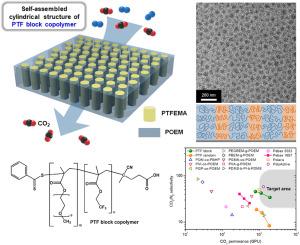用于二氧化碳捕集的单基质全聚合物薄膜复合膜的实验和模拟研究:嵌段共聚物与无规共聚物
IF 9
1区 工程技术
Q1 ENGINEERING, CHEMICAL
引用次数: 0
摘要
我们开发了用于二氧化碳捕集的高性能、无添加剂、全聚合物薄膜复合膜(TFC),重点比较了由疏水性聚(2,2,2-三氟乙基甲基丙烯酸酯)(PTFEMA)和亲二氧化碳的极性聚(甲基丙烯酸氧乙酯)(POEM)链组成的嵌段共聚物和无规共聚物(简称 PTF)。通过自由基聚合(FRP)合成的 PTF 无规共聚物呈现出无序形态。与此相反,通过可逆加成-碎片链转移(RAFT)聚合合成的 PTF 嵌段共聚物则形成了有序的六角形柱状结构,形成了两亲、微相分离的纳米结构。分子动力学(MD)模拟显示,在这两种共聚物中,气体(CO₂ 和 N₂)与疏水性 PTFEMA 段的相互作用极小,而 CO₂ 与亲水性 POEM 段的亲和力很强。嵌段共聚物和无规共聚物表现出相似的 CO₂ 渗透性,这可归因于它们具有相似的 CO₂ 扩散性和溶解性。不过,嵌段共聚物的 N₂ 渗透率明显低于无规共聚物,从而使 CO₂/N₂ 的选择性提高了近四倍。在嵌段共聚物中观察到的较低的 N₂ 平均平方位移(表明扩散性降低)也支持了选择性的提高。PTF 嵌段聚合物的性能优于商用 Pebax 嵌段聚合物,其 CO₂ 捕获效率超过了 CO₂ 分离和捕获的工业标准。这使得单基质 PTF 嵌段共聚物有望成为混合基质膜的替代品,用于气体分离技术的实际应用。本文章由计算机程序翻译,如有差异,请以英文原文为准。

Experimental and simulation study of single-matrix, all-polymeric thin-film composite membranes for CO2 capture: Block vs random copolymers
High-performance, additive-free, all-polymeric thin-film composite (TFC) membranes were developed for CO₂ capture, focusing on a comparison between block and random copolymers (referred to as PTF) composed of hydrophobic poly(2,2,2-trifluoroethyl methacrylate) (PTFEMA) and CO2-philic polar poly(oxyethylene methacrylate) (POEM) chains. The PTF random copolymer, synthesized via free-radical polymerization (FRP), exhibited a disordered morphology. In contrast, the PTF block copolymer, synthesized via reversible addition-fragmentation chain transfer (RAFT) polymerization, formed a well-ordered hexagonally packed cylindrical structure, creating an amphiphilic, microphase-separated nanostructure. Molecular dynamics (MD) simulations revealed that in both copolymers, there was minimal interaction between the gases (CO₂ and N₂) and the hydrophobic PTFEMA segments, while CO₂ showed strong affinity for the hydrophilic POEM segments. The block and random copolymers demonstrated similar CO₂ permeance, which can be attributed to their comparable CO₂ diffusivity and solubility. However, the block copolymer exhibited significantly lower N₂ permeance than the random copolymer, resulting in nearly quadruple the CO₂/N₂ selectivity. This increase in selectivity was supported by the lower N₂ mean squared displacement (indicating reduced diffusivity) observed in the block copolymer. The PTF block copolymer outperformed the commercial Pebax block copolymer, achieving CO₂ capture efficiencies that surpass industrial standards for CO₂ separation and capture. This positions the single-matrix PTF block copolymer as a promising alternative to mixed-matrix membranes for practical applications in gas separation technologies.
求助全文
通过发布文献求助,成功后即可免费获取论文全文。
去求助
来源期刊

Journal of Membrane Science
工程技术-高分子科学
CiteScore
17.10
自引率
17.90%
发文量
1031
审稿时长
2.5 months
期刊介绍:
The Journal of Membrane Science is a publication that focuses on membrane systems and is aimed at academic and industrial chemists, chemical engineers, materials scientists, and membranologists. It publishes original research and reviews on various aspects of membrane transport, membrane formation/structure, fouling, module/process design, and processes/applications. The journal primarily focuses on the structure, function, and performance of non-biological membranes but also includes papers that relate to biological membranes. The Journal of Membrane Science publishes Full Text Papers, State-of-the-Art Reviews, Letters to the Editor, and Perspectives.
 求助内容:
求助内容: 应助结果提醒方式:
应助结果提醒方式:


